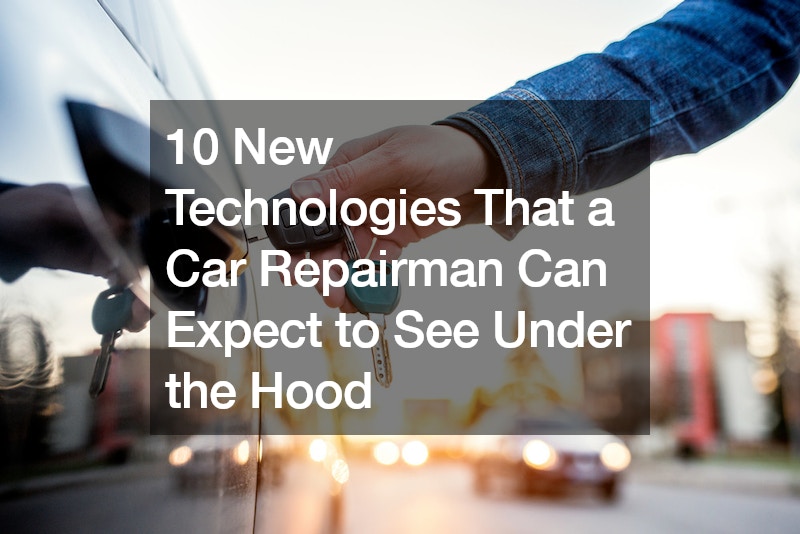
10 New Technologies That a Car Repairman Can Expect to See Under the Hood

Cars these days are like smartphones on wheels. With all the cool new features, they’re smarter, but fixing them? That’s getting trickier. Every time a car repairman pops open a hood now, they’ve got to be ready for a whole world of high-tech surprises.
The New Toolbox: Tech Skills for Today’s Car Repairman
Being a car repair whiz isn’t just about wrenches and oil anymore. It’s about keeping up with the techy side of cars. They’re not just vehicles; they’re like computers you can drive. Here’s the scoop on what the modern car repair pro needs to have in their toolkit:
1. Fighting Fire with Tech: The New Safety Norm

Safety’s a big deal, right? So, it’s vital for a car repairman to get the hang of the latest fire protection system design software. This stuff is complex – it’s all about sensors and systems working together to keep everyone safe from fires. By mastering this software, our repair heroes ensure all these high-tech sprinklers and sensors do their job. It’s not just about fixing cars; it’s about keeping drivers safe and sharp in the repair game.
2. Self-Driving Cars: A Whole New Road for Repairs and Insurance
Then there’s the big buzzword: autonomous driving. Self-driving cars are shaking up everything from how we drive to how we insure our rides. These cars are like rolling robots, loaded with sensors and AI. This means a car repairman needs to be part tech geek, diagnosing engines and the computers that drive these futuristic vehicles.
And guess what? This tech shift is also flipping the auto insurance world upside down. Less risk of accidents might mean cheaper insurance. But here’s the kicker: when a self-driving car gets in a crash, who’s to blame? The person in the vehicle or the company that made it? Car repair pros and insurance companies are navigating this new terrain, where a software glitch could be as big a deal as a flat tire.
3. AI Navigation: Your High-Tech Guide to Great Food and More
Think about driving through a busy city, your stomach rumbling, and you’re dreaming of delicious Italian food. Here’s where AI navigation becomes your new best friend. These smart systems do more than just show you the way; they can point you to the tastiest Italian restaurants, all based on your liking. They’re like digital know-it-alls, using heaps of data and traffic trends to give you the best routes and food recommendations on the fly.
But wait, there’s more. In self-driving cars, AI navigation is a game-changer. It’s like the car’s brain, making sense of everything around it to get you where you need to go safely. These systems are loaded with sensors and cameras, and they’re always learning, making them super smart co-pilots. Whether you’re a tech-savvy driver or just someone who appreciates a good pasta recommendation, AI navigation is seriously revolutionizing our drives.
Every car repairman needs to become an AI tech expert because of this. They need to know how these systems work, just like they do with engines and brakes. And the insurance industry is no different. With the rise of self-driving cars comes new risks, potentially shifting liability away from drivers and car manufacturers.
4. Smart Homes Just Got Smarter: AI and Your Automatic Gate

Welcome to the future, where your home is not just a building but a smart buddy, thanks to AI. Imagine an automatic gate that knows your car and talks to the other smart gadgets in your house. Like magic, You roll up, the gate opens, the house lights up, the temperature’s just right, and your favorite tunes start playing. It’s like living in a sci-fi movie, but it’s real and about making life easier and cooler.
But it’s not all about the cool factor. A gate hooked up to your smart home is a big win for security. It’s working with your home security system, keeping tabs on who comes and goes. This gate is smart enough to know your car from a stranger’s, adding an extra layer of safety. Every time you use it, it learns a bit more, getting better at making your home safe, secure, and just the way you like it.
So, a car repairman must know how smart home systems interact with your car. This can help them troubleshoot any issues, ensuring your gate and car are in sync. And as self-driving cars become more common, it’s not just about knowing how to fix engines and brakes anymore. Knowing AI navigation systems and their interactions with other smart home gadgets will be crucial for any repairman.
5. The Era of Customization: 3D-Printed Parts for Auto Hail Repairs
Every car repairman needs to know how to fix hail damage, and in today’s world, that includes being familiar with 3D-printed parts. With the rise of 3D printing technology, repairing hail damage has never been easier or more precise. Traditional methods of fixing hail damage involve filling and sanding dents by hand, which can be time-consuming and costly. But with 3D printing, a repairman can simply scan the damaged area and print out a custom-made part to fit perfectly on the car.
Not only does this save time and money, but it also allows for more customization in repairs. As each car model is unique, having 3D printing capabilities means that parts can be specifically designed for a particular make and model. This helps ensure a seamless repair job without any ill-fitting parts or gaps.
Moreover, 3D-printed parts can offer additional benefits such as improved aerodynamics and reduced weight. This is possible due to the freedom of design that 3D printing allows, unlike traditional manufacturing methods. Repairing hail damage with 3D-printed parts not only fixes the immediate issue but can also enhance the car’s overall performance.
6. Energy-Efficient Materials
Collision repair is common work for any car repairman. However, the existence of energy-efficient materials can make this complicated. Energy-efficient materials are designed to absorb energy instead of transferring it, which can be challenging for a repairman trying to fix damage from a collision.
In recent years, there has been a rise in the use of aluminum and carbon fiber materials in car manufacturing. While these materials efficiently reduce weight and improve fuel economy, they can also be challenging to work with during repairs. Repairmen need specialized training and tools to handle these materials, which can add to the overall cost of repairs.
However, technological advancements have also brought new solutions for repairing energy-efficient materials. For instance, carbon fiber repair kits are now available, making fixing damages on these types of cars easier. This saves time and money and ensures that the car maintains its fuel efficiency and performance.
7. Biometric Health Monitoring

Medical care and vehicles are now intersecting with biometric health monitoring systems. These systems use sensors, cameras, and other devices to monitor drivers’ health while driving. This technology can potentially prevent accidents caused by fatigue or other medical emergencies.
Every car repairman needs to know how all of these are connected. In case of a collision, they must be aware of the potential presence of these systems and how to handle them while repairing the car. Reinstalling or replacing damaged biometric health monitoring systems is crucial for ensuring the safety and well-being of future drivers. Properly handling these systems can also prevent any legal issues from failing to reinstall them correctly.
Furthermore, with the rise of autonomous vehicles, biometric health monitoring will become even more critical. These systems can monitor the driver’s vital signs and intervene to prevent accidents. These systems will likely become a mandatory part of car manufacturing, placing even more importance on understanding how to repair them.
8. Cybersecurity Measures
With the increasing connectivity of vehicles, cybersecurity has become an essential consideration for car owners and repairmen alike. Modern cars often feature sophisticated computer systems interacting with external networks, making them vulnerable to hacking and unauthorized access to car data. Cybersecurity measures in vehicles are not only about protecting the car’s software but also about safeguarding the drivers’ personal information.
For instance, a connected garage door system can be a potential entry point for cyber threats. If a vehicle is integrated with a home automation system, a breach in its cybersecurity could lead to unauthorized access to the garage and, ultimately, the home itself. Repairmen must understand the vehicle’s cybersecurity framework and how it interacts with peripheral devices like garage door systems to effectively address vulnerabilities and perform repairs without compromising the car’s security infrastructure.
The importance of cybersecurity measures goes beyond the vehicle itself and extends to protecting the vehicle’s ecosystem. Repair shops need secure data management systems, as their sensitive data could be a goldmine for cybercriminals. This includes proper encryption of diagnostic data, secure communication channels with car manufacturers for software updates, and regular training for staff on the latest cybersecurity threats and practices.
9. Vehicle Telematics
Vehicle telematics systems are at the forefront of transforming the automotive industry by enhancing the connectivity and intelligence of vehicles. These systems collect and send detailed data regarding vehicle operation, location, and diagnostics, contributing to driver safety, vehicle maintenance, and efficient fleet management. The relevance of telematics is increasingly significant in auto accidents — where an auto accident attorney can leverage the data collected to gain a comprehensive understanding of the collision’s circumstances.
Telematics technology has become invaluable in legal scenarios due to the precise data about speed, direction, and vehicle usage patterns. After an accident, analyzing this data by an auto accident attorney can reveal critical insights into driver behavior and road conditions, possibly influencing the outcome of legal proceedings. It shifts the paradigm from circumstantial evidence to data-driven conclusions, framing a more accurate and scientifically substantiated reconstruction of events.
Beyond legal matters, the telematic data contributes to preemptive safety measures and real-time emergency responses, potentially mitigating the impact of accidents or preventing them altogether. Insurance companies also utilize telematics to assess risk and tailor insurance premiums accordingly, providing incentives for safer driving habits. With the ever-growing integration of telematics into the automotive landscape, understanding its capabilities and implications enriches vehicle cybersecurity protocols and elevates road safety and legal responsibility standards.
Every car repairman needs to know vehicle telematics. This technology has revolutionized the automotive industry, from improving driver safety and vehicle maintenance to enhancing fleet management. With its vast potential to provide real-time data and insights, it has become a critical tool for auto accident attorneys, insurance companies, and law enforcement agencies.
10. AR Displays

Augmented reality (AR) displays are transforming the automotive industry, enhancing the driver’s perception of the external environment by overlaying digital information onto the real world. This cutting-edge technology integrates seamlessly into a vehicle’s windshield or dash, projecting critical data such as navigation, traffic information, and alerts without the driver needing to divert their eyes from the road. For instance, an AR display could highlight the road’s edges in foggy conditions or alert the driver to a potential hazard ahead.
The implications for engine repair are significant with AR displays. Professionals can receive real-time diagnostics and visual guides directly within their field of vision, allowing for a more informed and efficient repair process. This integration of AR technology can potentially reduce the time vehicles spend in the shop by aiding mechanics in pinpointing issues quickly and accurately. By improving the speed and precision of engine repair, AR displays contribute to the evolution of vehicle maintenance and enhance overall road safety by ensuring that cars function properly before returning to the road.
Being a car repairman can be challenging, especially if you’re not keeping up with the current technology. By following the tips above, you can be more efficient and knowledgeable in handling today’s modern cars. With the constant evolution of automotive technology, staying updated and adapting to new methods and tools is essential. Embracing these advancements will benefit repair professionals and improve the overall experience for customers by providing faster and more accurate repairs. Get ready to take on the new challenges of the future!


